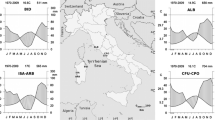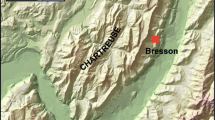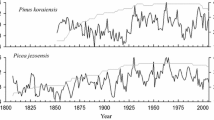Abstract
Distinct radial growth reductions in Cembran pine (Pinus cembra L.) were studied at the timberline on Mt. Patscherkofel (2246 m a.s.l., Tyrol, Austria), which is situated in the inner-Alpine dry region of the Central Austrian Alps. Six timberline stands with different aspects were sampled and ring-width chronologies developed based on dendroecological techniques. Growth-climate relationships between residual chronologies and climate variables were explored using Pearson product-moment correlation coefficients. P. cembra growth at the timberline appears to be limited by cool summer (June-August) and previous autumn (September-October) temperatures and low precipitation in late winter (March). Timberline stands show concurrent growth depressions lasting ≥ 5 yr during the periods 1815–1823, 1851–1858 and 1913–1920, indicating growth depressions were steadily decreasing. Although evaluation of climate data revealed that these growth depressions can mainly be explained by occurrence of cold growing seasons and therefore the influence of recent climate warming on tree growth is plausible, an effect of tree ageing on climate sensitivity may also be involved. On the other hand, climate extremes do not inevitably induce growth responses as would be expected from growth-climate relationships. This is explained by the occurrence of synergistic and/or compensating effects of growth limiting climate variables and preconditioning of tree growth in previous years. Comparison of growth reductions with two published P. cembra timberline chronologies from inner-Alpine dry locations in the Eastern Alps revealed that investigated stands show the highest climate sensitivity during the last 200 yr. This difference in growth response to climate variability is most probably related to the special climate situation at Mt. Patscherkofel, which is exceptionally windy throughout the year and frequently exposed to warm dry winds (Föhn).





Similar content being viewed by others
References
Baig MN, Tranquillini W (1980) The effects of wind and temperature on cuticular transpiration of Picea abies and Pinus cembra and their significance in desiccation damage at the alpine tree line. Oecologia 47:252–256
Beniston M, Innes JL (eds) (1998) The impacts of climate variability on forests. Lecture notes in Earth Sciences, vol. 74, Springer, Berlin
Blasing TJ, Solomon AM, Duvick DN (1984) Response functions revisited. Tree-Ring Bull 44:1–15
Böhm R, Auer I, Brunetti M, Maugeri M, Nanni T, Schöner W (2001) Regional temperature variability in the European Alps: 1760–1998 from homogenized instrumental time series. Int J Clim 21:1779–1801
Bradley RS, Jones PD (1993) ‘Little Ice Age’ summer temperature variations: their nature and relevance to recent global warming trends. The Holocene 3:367–376
Briffa KR (1992) Increasing productivity of “natural growth” conifers in Europe over the last century
Briffa KR, Jones PD (1990) Basic chronology statistics and assessment. In: Cook ER, Kairiukstis L (eds) Methods of dendrochronology. Kluwer, Dordrecht, 137–153
Bartholin TS, Berglund BE, Eckstein D, Schweingruber FH (eds) Tree rings and the environment. Lundqua Report 34, Lund University, Lund, 64–71
Cannell MGR, Smith RI (1986) Climatic warming, spring budburst and frost damage on trees. J Appl Ecol 23:177–191
Carrer M, Urbinati C (1996) A chronology of Pinus cembra (L.) in the Italian Eastern Alps. Dendrochronologia 14:209–215
Carrer M, Urbinati C (2001) Spatial analysis of structural and tree-ring related parameters in a timberline forest in the Italian Alps. J Veg Sci 12:643–652
Carrer M, Urbinati C (2004) Age-dependent tree-ring growth responses to climate in Larix decidua and Pinus cembra. Ecology 85:730–740
Carrer M, Anfodillo T, Urbinati C, Carraro V (1998) High-altitude forest sensitivity to global warming: results from long-term and short-term analyses in the Eastern Italian Alps. In: Beniston M, Innes JL (eds) The impacts of climate variability on forests. Lecture notes in Earth Sciences, vol. 74, Springer, Berlin, 171–189
Cook ER (1985) A time series analysis approach to tree-ring standardization. PhD thesis, University of Arizona, Arizona
Cook ER (1987) The decomposition of tree-ring series for environmental studies. Tree-Ring Bull 47:37–59
Cook ER, Holmes RL (1984) Program ARSTAN User Manual. Laboratory of Tree Ring Research. University of Arizona, Tucson, USA
Eckstein D, Aniol RW (1981) Dendroclimatological reconstruction of the summer temperatures for an alpine region. Mitt Forstl Bundesvers Wien 142:391–398
Ellenberg H (1988) Vegetation ecology of Central Europe. Cambridge University Press, Cambridge
Ettl GJ, Peterson DL (1995a) Growth response of subalpine fir (Abies lasiocarpa) to climate in the Olympic Mountains, Washington, USA. Global Change Biol 1:213–230
Ettl GJ, Peterson DL (1995b) Extreme climate and variation in tree growth: individualistic response in subalpine fir (Abies lasiocarpa). Global Change Biol 1:231–241
FAO (1998) World reference base for soil resources. FAO, Rome
Fliri F (1975) Das Klima der Alpen im Raume von Tirol. Universitätsverlag Wagner, Innsbruck
Frenzel B, Maisch I (1981) Klimatische Analyse der Jahrringbreiteschwankungen an der alpinen Waldgrenze. Mitt Forstl Bundesvers Wien 142:399–416
Fritts HC (1976) Tree rings and climate. Academic Press, London
Gindl W (1999) Climatic significance of light rings in timberline spruce, Picea abies, Austrian Alps. Arctic Antarctic and Alpine Res 31:242–246
Grace J (1977) Plant response to wind. Academic Press, London
Graham RL, Turner MG, Dale VH (1990) How increasing CO2 and climate change affect forests. Bio Sci 40:575–587
Graumlich L, Brubaker LB, Grier CC (1989) Long-term growth trends in forest net primary productivity: Cascade Mountains, Washington. Ecology 70:405–410
Hadley JL, Smith WK (1983) Influence of wind exposure on needle desiccation and mortality for timberline conifers in Wyoming, USA. Arctic and Alpine Res 15:127–135
Havranek W (1972) Über die Bedeutung der Bodentemperatur für die Photosynthese und Transpiration junger Forstpflanzen und für die Stoffproduktion an der Waldgrenze. Angew Bot 46:101–116
Hellrigl K (1985) Observations on bark beetles (Coleoptera, Scolytidae) in twigs of Pinus cembra in South Tyrol (Austria). Anz Schädlingskunde Pflanzenschutz Umweltschutz 58:108–110
Holmes RL (1994) Dendrochronology program library user's manual. Laboratory of Tree-Ring Research. University of Arizona, Tucson, USA
Holtmeier FK (1994) Ecological aspects of climatically-caused timberline fluctuations. In: Beniston M (ed) Mountain environments in changing climates. Routledge, London, New York, 220–233
Hurst A (1987) Wirkung von Bodenabkühlungen auf die Wasserbilanz und das Wachstum von Bäumen. PhD-thesis, ETH-Zürich, Switzerland
Hüsken W (1994) Dendrochronologische und ökologische Studien an Nadelhölzern im Gebiet der Pragser Dolomiten (Südtirol/Italien). Dissert. Bot. 215, Cramer/G. Borntraeger, Berlin Stuttgart
Hüsken W, Schirmer W (1993) Drei Jahrringchronologien aus den Pragser Dolomiten/Südtirol. Dendrochronologia 11:123–137
Innes JL (1994) Climatic sensitivity of temperate forests. Env Poll 83:237–243
Körner C (1998) A re-assessment of high elevation tree line positions and their explanation. Oecologia 115:445–459
Körner C, Paulsen J (2004) A world-wide study of high altitude treeline temperatures. J Biogeogr 31:713–732
Kronfuss H, Havranek WM (1999) Effects of elevation and wind on the growth of Pinus cembra L. in a subalpine afforestation. Phyton 39:99–106
LaMarche VC, Fritts HC (1971) Tree rings, glacial advance, and climate in the Alps. Z. Gletscherk. Glazialgeol 7:125–131
Loris K (1981) Dickenwachstum von Zirbe, Fichte und Lärche an der alpinen Waldgrenze/Patscherkofel. Mitt Forstl Bundesvers Wien 142:417–441
Luckman BH, Kavanagh TA (1998) Documenting the effects of recent climate change at treeline in the Canadian Rockies. In: Beniston M, Innes JL (eds) The impacts of climate variability on forests. Lecture notes in Earth Sciences, Springer, Berlin, 121–144
Michaelis P (1934) Ökologische Studien an der alpinen Baumgrenze. IV. Zur Kenntnis des winterlichen Wassserhaushaltes. Jahrb wiss Bot 80:169
Motta R, Nola P (1996) Dendrochrono-ecological signal in three stone pine (Pinus cembra L.) chronologies from the western Italian Alps. Dendrochronologia 14:43–57
Neuwinger I (1970) Böden der subalpinen und alpinen Stufe in den Tiroler Alpen. Mitt Ostalpin-Dinarische Ges Vegetationsk 11:135–150
Nicolussi K (1994) Jahrringe und Massenbilanz. Dendroklimatologische Rekonstruktion der Massenbilanzreihe des Hintereisferners bis zum Jahr 1400 mittels Pinus cembra-Reihen aus den Ötztaler Alpen, Tirol. Zeitschr Gletscherk Glazialgeol 30:11–52
Oberhuber W (2004) Influence of climate on radial growth of Pinus cembra within the alpine timberline ecotone. Tree Physiol 24:291–301
Oberhuber W, Kofler W (2003) Effects of climate and slope aspect on radial growth of Cembran Pine (Pinus cembra L.) at the alpine timberline ecotone on Mt. Patscherkofel (Tyrol, Austria). Austr J For Sci 120:39–50
Paulsen J, Weber UM, Körner C (2000) Tree growth near treeline: abrupt or gradual reduction with altitude? Arctic Antarctic and Alpine Res 32:14–20
Peterson DW, Peterson DL (1994) Effects of climate on radial growth of subalpine conifers in the North Cascade Mountains. Can J For Res 24:1921–1932
Petitcolas V, Rolland C (1996) Dendroecological study of three subalpine conifers in the region of Briancon (French Alps). Dendrochronologia 14:247–253
Pilcher JR (1990) Sample preparation, cross-dating and measurement. In: Cook ER, Kairiukstis LA (eds) Methods of Dendrochronology. Applications in the Environmental Sciences. Kluwer, Dordrecht, 40–51
Pitschmann H, Reisigl H, Schiechtl HM, Stern R (1980) Karte der aktuellen Vegetation von Tirol 1/100.000. 7. Teil: Blatt 10, Ötztaler Alpen, Meran. Doc Cartogr Ecol Grenoble 23:65–84
Rolland C, Petitcolas V, Michalet R (1998) Changes in radial tree growth for Picea abies, Larix decidua, Pinus cembra and Pinus uncinata near the alpine timberline since 1750. Trees 13:40–53
Schweingruber FH, Kairiukstis L, Shiyatov S (1990) Sample selection. In: Cook ER, Kairiukstis LA (eds) Methods of Dendrochronology. Applications in the Environmental Sciences. Kluwer, Dordrecht, 23–35
Schweingruber FH, Briffa KR, Jones PD (1991a) Yearly maps of summer temperatures in Western Europe from A.D. 1750 to 1975 and Western North America from 1600 to 1982: Results of a radiodensitometrical study on tree rings. Vegetatio 92:5–71
Schweingruber FH, Wehrli U, Aellen-Rumo K (1991b) Weiserjahre als Zeiger extremer Standortseinflüsse. Schweiz Zeitschr Forstw 142:33–52
Siebenlist-Kerner V (1984) Der Aufbau von Jahrringchronologien für Zirbelkiefer, Lärche und Fichte eines alpinen Hochgebirgsstandortes. Dendrochronologia 2:9–29
Tranquillini W (1959) Die Stoffproduktion der Zirbe (Pinus cembra L.) an der Waldgrenze während eines Jahres. Planta 54:107–151
Tranquillini W (1963) Climate and water relations of plants in the sub-alpine region. In: Rutter AJ, Whitehead FH (eds) The water relations of plants. Blackwell, Oxford, 153–166
Tranquillini W (1979) Physiological ecology of the alpine timberline. Tree existence in high altitudes with special reference to the European Alps. Ecological studies 31. Springer, Berlin Heidelberg New York
Turner H, Streule A (1983) Wurzelwachstum und Sproßentwicklung junger Koniferen im Klimastress der alpinen Waldgrenze, mit Berücksichtigung von Mikroklima, Photosynthese und Stoffproduktion. Internationales Symposium Wurzelökologie, Gumpenstein, 617–635
Urbinati C, Carrer M, Sudiro S (1997) Dendroclimatic response variability of Pinus cembra L. in upper timberline forests of Italian Eastern Alps. Dendrochronologia 15:101–117
Villalba R, Veblen TT, Ogden J (1994) Climatic influences on the growth of subalpine trees in the Colorado Front Range. Ecology 75:1450–1462
Villalba R, Boninsegna JA, Veblen TT, Schmelter A, Rubulis S (1997) Recent trends in tree-ring records from high elevation sites in the Andes of northern Patagonia. Clim Change 36:425–454
Wardle P (1971) An explanation for alpine timberline. New Zeal J Bot 9:371–402
Wardle P (1981) Winter desiccation of conifer needles simulated by artificial freezing. Arctic and Alpine Res 13:419–423
Wieser G (2004) Seasonal variation of soil respiration in a Pinus cembra forest at the upper timberline in the Central Austrian Alps. Tree Physiol 24:475–480
Acknowledgments
This research was supported by the Austrian (Federal) grants “Fonds für wissenschaftliche Forschung”, Project-No. P14554-BOT “Variability of the growth-climate relationship of Cembran pine (Pinus cembra L.) at the alpine timberline ecotone”. We gratefully acknowledge the climate data provided by “Zentralanstalt für Meteorologie”, Innsbruck. We also thank two anonymous reviewers for valuable suggestions on improving the manuscript.
Author information
Authors and Affiliations
Corresponding author
Rights and permissions
About this article
Cite this article
Pfeifer, K., Kofler, W. & Oberhuber, W. Climate related causes of distinct radial growth reductions in Pinus cembra during the last 200 yr. Veget Hist Archaeobot 14, 211–220 (2005). https://doi.org/10.1007/s00334-005-0001-2
Received:
Accepted:
Published:
Issue Date:
DOI: https://doi.org/10.1007/s00334-005-0001-2




